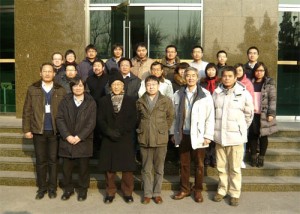When the New Year’s bell was still echoing in the air, physicists from China and Japan gathered in Beijing to attend the fifth IHEP-KEK collaboration meeting on 1.3-GHz superconducting radiofrequency (SRF) technology which was held at the Institute of High Energy Physics (IHEP), Chinese Academy of Sciences from 7 to 8 January 2013. Six high-energy accelerator experts from KEK and Kyoto University and nearly twenty physicists from IHEP participated.

Paticipants of the fifth IHEP-KEK 1.3-GHz technology collaboration meeting on superconducting radiofrequency (image/IHEP)
The meeting was co-chaired by Jie Gao, member of the future Linear Collider Board, chair of the Asian Linear Collider Steering Committee and chief scientist of the ILC group at IHEP, and Kaoru Yokoya, member of the ILC steering committee and the Asian regional director of the GDE.
“The aims of this meeting are to review the progress of the IHEP-KEK collaboration on 1.3-GHz superconducting radiofrequency (SRF) technology, to promote the future collaboration on ILC superconducting linac, and to be better prepared for the formal construction of the ILC project through international collaboration,” said Gao.
During the meeting, experts from KEK and IHEP gave eleven talks to review the progress on the1.3-GHz SRF technology collaboration and proposed the next collaboration plan. Six years of research and development work from KEK scientists and industrial collaborators has successfully led to the satisfying fact that an average accelerating gradient of 35 MV/m was achieved with 90% yield of the TESLA-like nine-cell cavities in industry, which meets the technical design specification for the ILC project. KEK has developed a 40-MeV linac where a collision experiment between electron beams and a laser was conducted. Four nine-cell cavities passed the test on STF phase-1, and eight nine-cell cavities (four of them from FNAL and DESY) were successfully tested in the S1-Global experiment.
Based on these successful experiences, KEK is planning to build an 800-MeV test facility to develop and operate more new nine-cell superconducting cavities, called STF phase-2. KEK has also built an advanced Cavity Fabrication Facility to reduce the cavity costs, improve manufacturing efficiency and lay the foundation for technology transfer and future mass production.
Supported by technology innovation funds of IHEP, the project of 1.3-GHz superconducting accelerating unit has made important progress. All the key-component R&D tasks have been completed and are under test, which include large-grain low-loss nine-cell superconducting cavities with full end groups, high-power input couplers, tuners, LLRF, cryomodules, etc. The assembly of the unit will be conducted in 2013, and horizontal test is scheduled in 2014. This would be the first ILC superconducting linac test unit developed in China and is of great significance to the ILC R&D and key technology research on XFEL and ERL projects in China.
IHEP is also doing R&D of the TESLA-like 1.3-GHz nine-cell superconducting cavities in collaboration with KEK. In the meeting, both sides exchanged ideas on the R&D problems of the key components and discussed the arrangement for the test of the IHEP 1.3-GHz high-power input coupler and TESLA-like nine-cell cavities at KEK this year. Scientists achieved consensus on future cooperation on ILC SRF technology and promotion of the industrialisation of the 1.3-GHz nine-cell cavities and cryomodules.
Kaoru Yokoya concluded: “The draft of the ILC Technical Design Report has been finished, and the final version which included the cost estimation chapter will be released to the public in June 2013. Lyn Evans was appointed to be the Director of the new Linear Collider Collaboration under the new oversight committee, the new Linear Collider Board. In the following three to five years, the site selection for the ILC project will be the main task. Japan has now emerged as a possible host for the ILC project. As neighbours in Asia, Japan and China should play a more active role in the R&D and construction of ILC project.”

Recent Comments